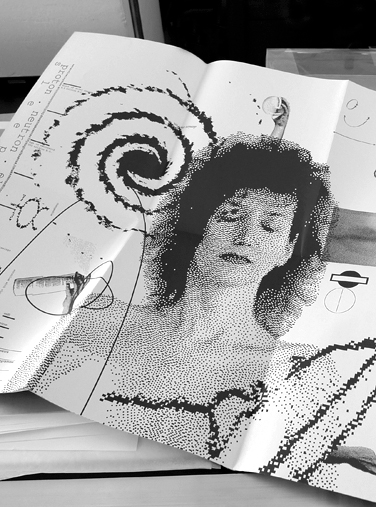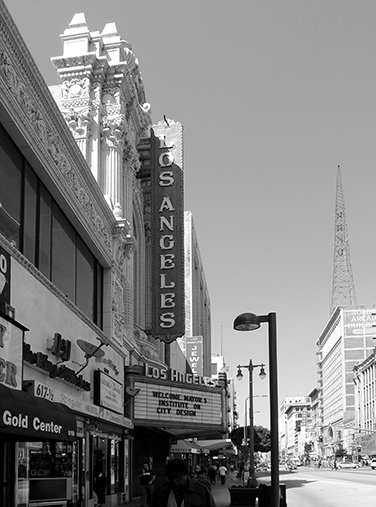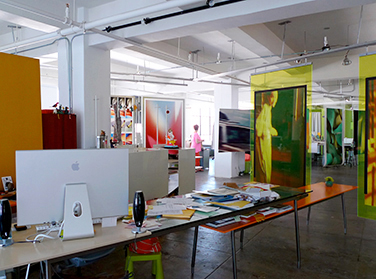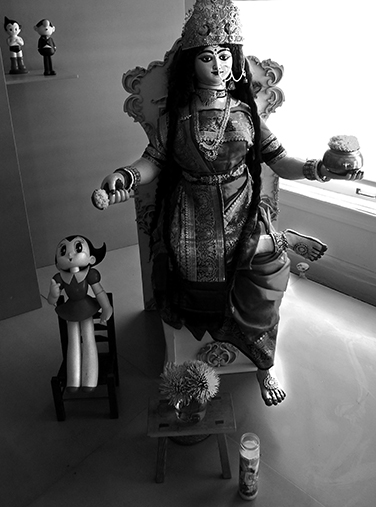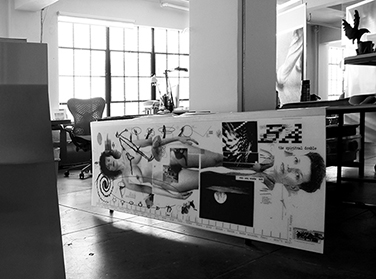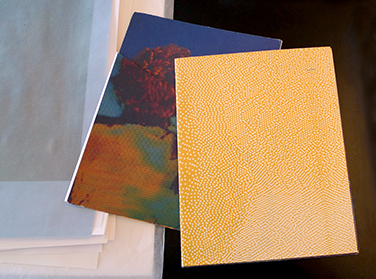Interview
An American graphic designer, April Greiman is widely recognized for pioneering the use of digital technology as a medium for design. She is also credited with introducing and contributing to the development of the New Wave style in the US.
Greiman studied at the Schule für Gestaltung Basel in 1970, under influential figures such as Armin Hofmann and Wolfgang Weingart. Despite her short time in Switzerland, she left an indelible mark on the Swiss design scene by appearing in one of Weingart’s most infamous covers for Typografische Monatsblätter, for issue 6/7 of 1973. She would later become one of his most celebrated former students.
The designer returned to the US following her studies, and settled in Los Angeles in 1976, where she established the multidisciplinary practice Made in Space. Working with the photographer Jayme Odgers, she created artworks that embody the New Wave style, a design approach that is associated strongly with 1980s California. Furthermore, Greiman initiated a hybrid-based approach that combined analog and digital components, while also developing an expressive typographical style at the same time. By integrating typography, video, and digital media, she created striking graphics that can be situated within the avant-garde of the 1980s.
Primarily owing to a successful synthesis of her training in Switzerland and of technological advancements taking place in California at the time, Greiman has produced innovative artworks that are considered benchmarks in the history of graphic design. Her ongoing willingness to experiment and her “forever a student” attitude continue to inspire.
Louise Paradis You used to work at Sci-Arc (Southern California Institute of Architecture, in Los Angeles). What did you do there?
April Greiman My studio, Made in Space, was the consulting firm that did the graphic design and the brand/identity for the school for about eight or nine years from 1987. Later, I re-did the identity again.
LP And how was it working there?
AG Their publications director, Margi Reeve, would determine what projects they wanted to do every year. Then there were some little things they used to give to freelance people, and so when they commissioned work with other designers they usually used the templates we initiated and designed: the logotype and the basic typefaces. They would also hire students who made lecture-series posters, which kept the “image” fresh.
LP Why did you go to Basel after graduating from Kansas City Art Institute [KCKI]?
AG I had three teachers from the Schule für Gestaltung Basel when I was at Kansas City—Inge Druckrey, Hans Allemann and Christa Zelinsky. They were all from Europe and had to leave when their visas expired. Feeling incomplete with my undergraduate education, I decided I would do graduate work in Basel. It was in 1970. We didn’t have a type shop in Kansas City and we were using Letraset, which wasn’t professional enough for me. I also always liked and used words and their roots in my design work, making words “editorial” and narrative in their own right. So I just knew I needed to know more about fine typography to complete my design education. That is why I went to Basel, really.
LP Were you expecting to encounter a modernist style there?
AG I was probably one of the youngest people in the class, and I really didn’t have any expectations. I just needed to learn typography. We also had an important exhibition of Armin Hofmann’s posters at our school in Kansas City. I just remember it to be such a pivotal experience for me. I didn’t know who he was when I walked into the gallery. I mean, I heard his name and we looked at his published books, but when I saw the posters in person, I felt like I needed to go directly to the source, which is what I did! He was such an influential force in my earlier years.
LP Did you know that Wolfgang Weingart was teaching there?
AG No, because he only started teaching a few years before and had nothing published yet. I was really quite uninformed, but truly inspired by my seeing Hofmann’s work.
LP Were there a lot of international students?
AG Yes, it was all international students. In a class of 15 or so, there were two French Canadians, one German, one Swiss, one French, about three students from India, and about five Americans. The program proposed “further development:” what we refer to here in the US as an extension program. Students go to school, get their degrees then go out and work professionally in their chosen field. Then they realize later the value of a higher education and want to continue some advanced work or project, learn new skills.
LP So had most people worked before?
AG I was only 21. People were generally five years or even a bit older than I. My going there was a bit of a fluke, because during Hofmann’s exhibition at KCAI he made a visit and gave a lecture at the college. I talked to the head of our design program, Rob Kelly, and said, “Could I speak with Mr. Hofmann about studying in Basel?” And he said, “What for?” … “Because I may want to go there and study typography.” So he set up an appointment with Hofmann and I met with him. He went through my portfolio in about two minutes and asked, “What do you want?” to which I replied, “What does it take to go to the Basel School?” He answered, “Just show up in September.” And so I did! When I showed up, I realized it does not work like that in Switzerland at all!
LP That is really funny. He told you to just show up?
AG Yes, and I took him at his word. So I just showed up in Basel and they directed me to the administration office. The lady in the administration office didn’t speak English, so I kept saying to her, “Armin Hofmann, Armin Hofmann.” They called him to the office, and he came down after about half an hour. He looked at me and said, ‘What are you doing here?” I replied, “You told me to just show up.” He was really shocked. He said, “Nobody has ever done that.” I replied, “But you said to.” He said, “I know, but you have to fill out forms for the Swiss government prior to coming here.” I think he may have called me stupid, but I’m not sure, as my Swiss dialect wasn’t very attuned at that time. Obviously I was very naive, but at the same time very excited, and not about to return home to New York. I never felt well physically while in Basel. I don’t know why, I felt like I, or Basel, might be a bit haunted. I focused very hard on my projects in the type shop, and I worked closely with Weingart. He made special exceptions so I could go into the type shop on the weekend and at night. He was really accommodating and very generous with his time and with me. Yet still, physically I felt ill, it was a very strange time for me. So I worked really hard, thinking I might have to leave the school sooner than planned. I had no social life. I made a plan to leave and return home after my second term in school. My mother, aunt, and cousin had never been to Switzerland, so the plan was to meet me there and then we were going to fly to England and travel around Europe for about a month. When Hofmann found out I was leaving the school I think he was confused. “Why are you leaving so soon?” he asked. I told him I was often ill and felt I needed to leave Basel. He answered, “No, no, can you wait right here for a moment?” He went away for half an hour and came back. “Would you like to live with my wife and I, finish your studies?” In trade for his helping me continue my studies I had to watch their two young children, Konrad and Matthias.
LP He proposed that you should live with him and his wife?
AG Yes, in Ticino, the Italian part of Switzerland. At first I said, “No, I am leaving: my family is here and we are going to travel.” But he made such a big fuss that I talked to my mother and family. We were traveling and touring to the north, to England, and instead we went south, to Italy, and the southern part of Switzerland. We went down there with my mother and family to meet his wife, Dorothea Hofmann—Dorothea is one of my most favorite women on the planet, by the way. Ticino was so beautiful, not at all like Basel, which I liked, and it was during the summer, which was a special warm and balmy season. He said, “Why don’t you try it for a while?” That was it. I got a chance to study with the master privately there, so I did!
LP So you stayed there?
AG Yes, we stayed in a village of around 28 people, with a single lane road going up the mountain to it. Dorothea didn’t drive, and Hofmann had an old Peugeot—with a stick shift. My father taught me how to drive a stick-shift car at the age of 14, so they were happy that I would pick up Hofmann from the train station on Thursday night from Basel and take him back to the train on Sunday afternoon. He would spend the weekend in Ticino with us. Dorothea, as we all well know, is an amazing draftswoman, and I took my first and only drawing lessons from her, fortunately, as we didn’t have drawing classes in our undergraduate education. She would give me drawing lessons in the morning, and then in the afternoon I would watch her children for perhaps two or three hours. During that time she would work on lithos and prints, as she had a press in the basement of their house. Sometimes, on the weekend, I would work with Hoffman on color studies. Armin would look at what I had been doing during the week, rarely making a comment. I also went back to Basel once a month and worked with Weingart to complete some typography projects. He was, again, very generous in his help, encouragement, and inspiration. I remember having many great laughs and special times with him and a select group of other students.
LP How long did you stay with the Hofmanns?
AG Such a short time, only about three months. Then I got a telegram in our little village, Gadero, inviting me to teach at the Philadelphia College of Arts [now the University of the Arts]. I thought this telegram was a mistake and I ignored it. Then I got another one. This was very confusing, and in this little village it was a big thing. I asked Hofmann about this and he said, “Oh yeah, I recommended you to teach there.” I replied, ”Oh no, I don’t want to teach, I’m not ready yet, I am still a student.” He replied, “Well, you can’t stay here any longer.” I replied, “But I don’t want to teach.” And he said, “Oh yes, you will.” And so he pushed me “out of the nest,” so to speak. I didn’t speak to him for years as it was so hard for me to accept this responsibility, and I thought he wasn’t interested in me and my work, so took it as an offense. And so, off I went and taught typography in Philadelphia. It was ridiculous, because I didn’t know very much myself, but that is what happened, and in retrospect, to my great fortune.
LP Weingart put a picture of you on one of his famous cover series of 1972–73 for Typografische Monatsblätter. How did that come about?
AG He had a costume party. I don’t remember, maybe it was a Renaissance-themed party. We were maybe a dozen guests and all wore rented costumes, and I donned a rented Renaissance-type dress. Weingart took that picture of me, which is the one on that cover. I never liked this picture, by the way, particularly when it showed up as a cover on such a prestigious magazine.
LP And he added on the cover the title “April Greiman 28.1.1971: I am feeling typography.”
AG This was, I think, because he asked me once, “Tell me about what you are doing and your approach to typography.” I answered, “I can’t talk about it now, I am feeling typography.”
LP Did you work closely with Weingart?
AG Yes, like everybody did in our class. I was so unhappy and ill in Basel, wanting to get out of the school as quickly as possible … I also took a painting class while there. Basically all the classes I took were Hofmann’s class and typography with Weingart. That was it. It was helpful that Weingart really liked me, so he made special arrangements for me to work in the type shop. I was a bit of … a teacher’s pet. Although I was not technically very proficient, I learned how to hand set type, use a proofing press, and the rest of my studies were very experimental … He really started a typo-revolution. It was all very Dada and Constructivist for me. The Dadaists and the Constructivists used words and “said” something more than just the name and date of an event: they took a position, were political. I may be wrong, most likely, but Weingart was, I think, picking up on that tradition, creating “narrative” with type. He seemed to understand the special “complexion” of our class, and made it very playful and open-ended.
LP How did he encourage experimentation?
AG He would give us assignments that were as simple as making a calendar or making a timetable, but with a twist. What is the fast train called again?
LP TGV?
AG TGV, yes. So you would have real information that you would have to organize, but then he would encourage to go beyond that. It was a train timetable, but it was visually exciting and maybe had another imbedded message or meaning, like conveying speed or movement in space and time.
LP I have seen in an issue of TM from 1975 a special article that carried your name. But you told me you never contributed to that magazine, right?
AG I don’t remember it. Maybe I did, I don’t know. I do forget a lot about those days, it is shocking. I’ve never had a good memory. I’ve always thought of myself as somebody who is more in the present or the future.
LP After your time in Basel and Ticino, you decided to go back to the US to teach …
AG I was kind of forced to teach, as I mentioned before, and I started freelancing, and then I was teaching and working in a marketing and design firm called Anspach/Grossman/Portugal [AGP]. Initially I worked there only for a few days a week and went to Philadelphia for a day a week to teach. Then I started to work at AGP full time. I only taught in Philadelphia for about four years.
LP Were there other people from Switzerland who were teaching there?
AG All of my teachers from undergraduate were teaching there—Inge Druckrey, Hans Allemann, and Christa Zelinsky—all the teachers I had in Kansas City.
LP And when you later studied at Yale University, in early 1970s, were there a lot of Swiss designers [teaching/studying] there too?
AG Maybe. Over time a lot of people from Basel came to teach at Yale and Philadelphia. There was Dan Friedman.
LP Were you at Basel at the same time as Dan Friedman?
AG No, I was there a few years later. I think he was … I can’t remember, maybe five years older than me, I could be wrong …
LP Do you think your time in Basel had a strong influence on your work?
AG Yes. Weingart likes to take a lot of credit for everything that is formal, and he certainly is deserving of it, but one of the important things I learned from him was how to work; a healthy process. It was more of a process of discovery and exploration than of trying to make something that looks like the teacher’s or anybody else’s work. When he gave an assignment, he would encourage us to work on 20 different iterations all at the same time. I found that method very useful. Also, when I got a computer I could do the same kind of thing, because you can archive so many different versions and save them, then pick the one which is the most appropriate. They may all be good solutions, but maybe only one is really appropriate. I think that is the strongest thing I learned from Weingart: a playful, beginner’s-kind-of Weingart mind. In retrospect, I remember I was so nervous about going to Basel, thinking it was going to be hard to learn how to be a typesetter and run a printing press, but once I got there, oh my God, the atmosphere in the class was very delightful and full of spirit. In his class there really weren’t any mistakes, and you just tried things. Weingart was so very encouraging.
LP Were there more men than women or was it pretty balanced?
AG There were three women in the class and about 12 men.
LP So men were the majority …
AG As usual. It was like that up until the last 20 years.
LP At what point did you decide to go to California?
AG I was working in New York and I went to my first Aspen Design Conference in 1976. I met some very special and friendly people in Aspen, from Los Angeles, and I had a wonderful time socializing with them. I was going out to San Francisco to see my in-laws, and they said, “If you are going to be in San Francisco, we are going to buy you a ticket to Los Angeles.” So I came down here for a few days and I really liked it. At the time I was working in New York for the Museum of Modern Art, with the curator of design, Emilio Ambasz. After working on an exhibition design and its catalogue, I was very disillusioned, because I did some really nice typography for both, but couldn’t present my own work as it was a big institution and he had to present it instead. They started making changes saying, “We don’t understand why certain words are bigger. We don’t understand why there are different typefaces.” My design got pretty watered down, so I finished that and left, because I didn’t want to work there anymore due to museum politics. I think I worked there for almost two years with Ambasz. I worked on his own personal projects and was responsible for the graphic design and standards manuals for some new endeavors of his. And then I was offered a couple of job interviews in Los Angeles, and the various companies flew me out to the West Coast. As it turned out, I really liked Los Angeles, and thought I would just come out here for maybe six months to a year. Then I discovered the desert, and I moved here permanently in 1976. I never went back to pick up my things in New York. I just drove out here with my little 2002-model BMW—a little blue car I drove all the way across the country. All I had when I came here were a suitcase and a plant.
LP Were you aware of TM magazine back in the day?
AG TM? Oh yeah! That was the magazine, because it had such a long tradition, with many good articles and good covers. It was that and Graphis magazine. Graphis was more internationally known as a graphic-design magazine. The content wasn’t as trade-oriented, it was more personality and “high-design”-oriented. Whereas TM, you know, anybody who really knew fine typography would know it … That was really the magazine for the trade, but it was very unusual in that it had really good content. How did you get into TM? It is really bizarre!
LP The first time I saw TM was on a Flickr account. A guy had almost all the covers photographed, and I thought they looked so nice. Then when I was studying in Switzerland I tried to figure out my theory/research project. I first wanted to do it about Modernism, and then about the transition from Modernism to Postmodernism, and one of my tutors told me I should consider TM as a field to look at those changes. I think those magazines are gems that were just waiting to have the dust blown off them.
AG Time capsules! A lot of them weren’t so … I mean, they had nice typography but weren’t … Once you have seen Weingart’s designs or seen experimental typography, TM just looks like a nice, well-designed magazine, but pretty understated. I think Weingart breathed new life into it. He designed a lot of covers, and that attracted a younger and more international audience. I mean, it is one of the only typography magazines that have ever existed in the world, as far as I know.
LP Some people say that Weingart is the father of the New Wave style, do you think so?
AG I would say that too.
LP And some also say that you introduced it to the US. Do you agree with that?
AG Well, I think I would agree with that if you look at the lineage from the Basel school. But you have Emigre magazine, designed by Rudy VanderLans and Zuzana Licko, who were my peers, and greater typographers, and had as much influence, if not more, than I did because they made a magazine. But they weren’t students of Weingart. You could say that in the lineage starting with Basel and Weingart I am probably the one who … I don’t know, I just had a few clients when I came out here, and, you know, it was still conservative typography, but it was also quite different to everybody else.
LP There have been a lot of technological changes since you entered the field of graphic design. Hand typesetting, phototypesetting, computers …
AG I actually took a computer-programming course at Yale in the early 1970s as well, because I wanted to learn about new technology. In order to use certain of their computers, I had to take a programming class which gave me a migraine every week. And about halfway through the course, when I was failing, because we had to learn Fortran—a very serious mathematical programming language—the teacher asked me, “What are your goals?” I replied, “I just want to learn how to use these computers because they are hooked up to phototypesetting devices.” He said, “I had no idea you were in the arts, you don’t need to take any more tests. Why don’t I just observe you using this equipment?” So I would just work on phototypesetting and explore. I don’t have any of that computer work anymore, because it was on photographic paper, and there was no way to fix the print, so it lasted as long as it lasted. From this summer course at Yale, I made a lot of things and learned how to actually use phototypesetting equipment. I don’t remember exactly what I did with it, maybe a calendar and some other posters, but the teacher gave me an A grade. Then in 1982 I became head of the design program at California Institute of the Arts, and in 1984 I changed the program name from Graphic Design to Program in Visual Communications. I also became interested in videography in the early 80s. I purchased my own professional equipment and I started shooting video and bringing it into my print graphics. There are some posters I made using video imagery. Next I had to learn how to use a high-end camera, because at that time the only way to get an image was to shoot off of a video monitor. Then I started to work on Video Paintbox, and I started renting time in different post-production facilities. And they caught on that I was not in the entertainment business; that I was trying to export imagery, kind of a hybrid between graphic/photographic/computer graphics. So the owners let me have time for free, and I did some professional work on $700-per-hour equipment. However, they let me take the graveyard shift to save money, and so I would go there at 10 o’clock at night and stay up all night working, exploring. I would do that for a week and they would provide a Paintbox “operator” who knew how to use the half-a-million-dollar software. Then the Macintosh came out. Oh, and I had an Amiga first …
LP What’s an Amiga?
AG The Amiga was a little computer, about the same size as a Macintosh when it first came out. It was a color computer, very primitive quality and resolution, and I struggled with it … I may have done one poster with the Amiga. Then the Macintosh came out and, bingo, there you go! I had been scared by all kinds of equipment and technology, but for me to thrive and feel good, I had to conquer it!
LP So basically, every time a new technology came out you felt scared but you needed to overcome it?
AG When I find something so terrifying I usually have to conquer it. It is like jumping into deep water without knowing how to swim. That would be me! The Harry and the Henry were the first editions of Quantel Paintbox, and they were video-resolution designed for broadcast use, which didn’t require being as high-res as was necessary for print graphics. So I learned a bit about them and their thinking, and that helped me a lot, having then a feeling for the technology and capabilities that would be our future. However, those Paintboxes couldn’t handle fine typography, designed more for a spinning logo, or a word that moved across the screen quickly.
LP I guess the Macintosh revolution really exploded in the US, particularly in California.
AG Again, I was at the right place at the right time. I had no interest in getting a computer, but I tried one and within the first two months they came on the market I bought it from Macy’s department store. That is where they were sold in Southern California. And I bought it thinking, you know, this will be fun. There was actually a very long line of people at Macy’s in 1984, waiting to try it. I was with a friend who finally said, “Let’s not wait in line anymore, just buy it.” And I said, “OK.” It was $3,200 or $3,600 for just 128K of memory. I am not kidding. I put it on my credit card and that was that! I did posters and works that had 20 overlays of acetate. I like that because it was really fine art, to really handle material and glue it down, overlay other materials, media, images. It was art and science merging, which were, and still are, my favorite things.
The above conversation took place in Los Angeles in August 2010. It was copy-edited by Ariella Yedgar.
